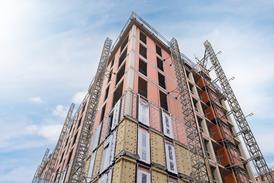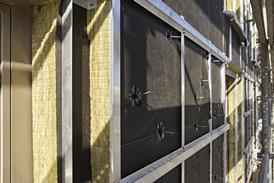By now, there should be an energy certification scheme in place for office buildings, but there isn’t. So Thomas Lane organised one for Ludgate House, the home of Building. Here’s what we found …
Being able to say exactly how energy efficient your building is has never been more important. Not only are energy prices escalating, but companies want to be able to say they are environmentally responsible, and to demonstrate this by occupying energy efficient buildings. In turn, developers want to provide them. Where the drive for improvement falls down is in the lack of any form of energy certification.
“Our members are always phoning us to ask when an energy certification scheme will be in place. Not having this is detrimental in terms of their development programme,” says Matt Smith, policy officer for the British Property Federation. “Energy ratings will also give landlords an idea of which areas of a building need to be improved.” Furthermore, if the call of Building’s 99% Campaign is to be answered and incentive schemes are to be introduced, there needs to be a way of identifying the efficiency of all buildings.
Even though there is an energy certification scheme in place for dwellings, there isn’t one for all other buildings. A scheme is being introduced in response to the Energy Performance of Buildings Directive, which requires every building to have its physical fabric rated and certified when all or part of it is sold or rented. The most likely candidate to calculate this rating is the same software tool used to calculate compliance with Part L – the Simplified Building Energy Model. But it’s proving something of a headache. “A couple of our members have tried to do an asset rating using SBEM and have retired hurt; it’s not an easy process,” warns Smith.
So, forewarned, Building decided use its own offices to see what the process of certifying an existing building involved. We engaged the services of John Field, who is an energy management specialist at Power Efficiency, a utility cost and energy management consultant, and the only company we have found that offers a trial rating using SBEM on existing buildings. Field is also the chairman of CIBSE’s carbon taskforce and the vice-chairman of its energy performance group, which happens to be looking at the energy certification process.
If anybody could get to grips with the complexities of working out an asset rating Field was the man.

Ludgate House
Building occupies part of Ludgate House, a 17-year-old 11-storey building in Blackfriars, London. It was perfect for the energy audit as it is a typical middle-aged, multi-tenanted air-conditioned office building. It is shallow in plan without an atrium. Net lettable space is 16,257 m² and gross floor area is 24,154 m².
The audit
Field came to Ludgate House to meet the head of facilities Stephen Vause, and Dermot Hughes, the building manager. They did not physically inspect the buildings or its plant – this would be too time-consuming and costly. Instead, they used the building’s details to fill in form after form, and these were later be entered into SBEM by Field back at his office. Details of all the services, the length of pipe runs, how the lighting is controlled, have to be entered in to SBEM in great detail. But some elements of the building are completely ignored. “You haven’t asked anything about the lifts,” says Vause.
“It doesn’t ask about lifts,” replies Field.
“We’ve spent an awful lot of time and effort selecting energy-efficient controls for the lifts,” says Vause, looking appalled. “That was part of our selection criteria.”
There’s not much Field can say. “It seems to be a gap in the system.”
Getting all the data needed for SBEM is onerous. For example, there are nearly 50 fans in Ludgate House and SBEM needs the power input and the rate of airflow of each to calculate fan efficiency.
Another problem is availability of data. Inevitably, some information, such as original plant manuals, will have been lost over time, and where data is unavailable a default position is assumed in order to complete the audit. This has a profound effect on the final asset rating, because the building’s age means that the default values tend to be unfavourable. “You can do a rating using the default positions and find you get a poor result,” says Field. “It really depends on the amount of time you are prepared to put in finding out all the detailed information to get a better rating.”

Accommodation
The lower ground floor contains a loading bay, computer rooms and plant rooms containing the boilers, chillers, backup generators, battery rooms and so on. The upper ground floor consists of more plant rooms, the reception and a cafeteria. Above this are eight floors of open plan office accommodation arranged around three cores. The central core contains the lifts and toilets and the north and south cores contain stairs and service lifts. The top floor contains meeting rooms and more plant rooms.
Furthermore, SBEM asks for information which really only applies to newer buildings. Air-pressure testing, for example, was not a requirement in 1989, when Ludgate House was built, so the information is not available. Again the default positions are not favourable and the onus is on the building operators to prove that it performs better than the default, which means undertaking expensive tests – Field reckons that such tests on Ludgate House would cost between £5000 and £10,000. “That is something you could do to gain some points,” says Field. “You might find it’s full of holes, though,” he adds. The cost of sealing measures is unknown, but could be expensive.
Field goes away to do some serious number crunching. One of the most time-consuming aspects of the calculation is having to divide the building into zones according to how close areas are to windows. When SBEM was introduced, services engineers complained that it wouldn’t allow them to zone buildings, which they do when designing air-conditioning systems. SBEM has been updated to allow for this, which means a lot of extra work for Field. Having gone through this process, and designed a spreadsheet to make it easier, Field believes he could do an energy audit in a day – providing all the relevant information was at hand.
The result
The efficiency of audited buildings is determined by comparing it with a notional building. Currently this notional building complies with the 2002 version of Part L of the Building Regulations. This is given an efficiency of 100%. A building with a score of less than 100% performs better than the notional building; one with more performs worse. The first calculation provided by Field shows our building has a score of 162%, that is, it is 62% worse than the notional building. Field says all the similar buildings he has used this system on have ratings of 140-170%.
So what rating would Ludgate House have on an A-G scale? We are still waiting for the Department for Communities and Local Government to say how the scores produced by SBEM relate to an A-G rating, so we have guessed how this might correlate, based on the already published rating system for dwellings (see table attached below). Based on this, Ludgate House has an E rating.

Lighting
T8 type fluorescent tubes are used for lighting office areas and are operated using time switches – there are no light level or occupancy sensors. The lighting has been upgraded on three floors – these have triphosphor coated tubes and high frequency ballasts to improve energy efficiency.

Cladding
The glazing has tinted double-glazed units. These wrap around the building in bands that alternate with solids areas of granite panels.
After the audit, however, Vause unearths some additional data, which could enable the poor default values to be overridden. The SBEM default for the glazing, for instance, assumes a U-value of 4 Wm2/K, which seems very high. After viewing the data, Field reckoned a figure of 2.8 Wm2/K would be fairer. Unfortunately, this does not affect the rating as, although less heating is needed because less heat is lost through the glass, more cooling is needed for exactly the same reason. Likewise, Field accepted that the boilers were more efficient than the default value and it turned out the lighting on three floors had been upgraded, too. This produced a final figure of 155%, also an E rating.
Although Vause would have liked a better rating, he is pleased the improvements he has made, such as the lighting upgrades, are reflected in the SBEM figures – the building is at least 7% better than the defaults. There are still big gains to be had in addressing the permeability of the envelope, the ducts and air-handling units, lighting efficiency, alarms on the metering systems and chiller and fan efficiencies. The ducts and the air-handling units would need to be tested separately at about £10,000 a time. Installing a metering system with alarms would cost £15,000.
Vause rules out air-pressure testing because it is expensive, disruptive and reducing permeability would be extremely difficult. However he says equipment such as lighting will be upgraded as it is replaced – improving the rest of the building’s lighting would cost about £40,000. Two chillers are due for replacement – again Vause says he will go for energy-efficient models.
Vause also says incentives would make a difference in that these would be factored into the case for improvement. “If there was a commercial case to warrant the expenditure and there was a payback period of two to five years we would do it.”



Heating and cooling systems
The building is cooled and heated using a full twin-duct variable-air-volume air-conditioning system. There is no heat recovery – conditioned air is re-circulated and topped up with fresh air. The first floor has a separate air-conditioning system following a change of use – hot and chilled water is supplied to air-handling units to condition this floor. A separate system has been installed to cool computer rooms, enabling the main system to be shut down in the evenings and weekends, thus saving energy. Three natural gas, central boilers supply the hot water. These are of a modular design and were recently upgraded to improve energy efficiency. There are two large and two small chillers supplying chilled water to the system.
.
How Ludgate House could get a C
Given its age it is hardly surprising that Ludgate House performs 62% worse than a comparable building constructed to 2002 Part L standards. Although there isn’t an official rating scheme in place yet, we think this would be equivalent to an E. This is based on the rating system for dwellings, in which the division between B and C correlates with the current version of Part L and an SBEM score of 72%. A zero-carbon building would be at the top of the A band, and could reasonably be expected to have a rating of 0%. Therefore there are two bands between a 2006 Part L building, and a zero-carbon one. If we take the 2006 Part L figure of 72% and divide it in two we get 36%, which we have used to define each band-width.
SBEM reckons the U-value of our glazing is 4 W/m2K, but we think it is 2.8 but as you can see it only makes a 2% difference in the SBEM score and doesn’t change the rating. Changing the U-value of the solid areas has no discernable effect. Improving the air permeability of the fabric from 10 to 5 m3/h/m2 would cut 9%. The same goes for leakage rates from the ducting and air-handling units which saves another 16% and takes the building up to a D. Fitting meters with alarms would save another 5%, and fitting more efficient lighting would gain 8%. We managed to prove that some energy-efficient lighting had been fitted which improved the rating – the final score for the building was 155%, also an E. Fitting more efficient plant also has a big impact – installing better chillers gains 16% and better fans another 8%, which takes the building into the C category.
(See table below)
What incentives are there?
Sticks
The 2006 Part L of the Building Regulations incorporates the Energy Performance of Buildings Directive requirement that when buildings larger than 1000 m2 have an extension added, or the building services capacity is increased, energy efficiency improvements must be made to the whole building. The value of the energy-efficiency improvements must not be less than 10% of the value of the main works. This is subject to the proviso that these measures have a payback period of less than 15 years.
Carrots
Two incentives are available to building owners: enhanced capital allowances and energy efficiency loans, both administered by the Carbon Trust.
Enhanced capital allowances are given for technologies that save energy and water. The energy saving technologies are services-related and include combined heat and power, heat recovery devices, energy-efficient lighting and boilers that are on an approved energy technologies list. The incentive is that companies can benefit from tax relief on the item immediately rather than getting it over a period of several years, thus saving money. The downside of the scheme is that it doesn’t apply to other improvements such as upgrading the building fabric, and it only benefits companies in profit.
Energy efficiency loans are interest-free and available to small and medium-sized enterprises. The loans must be for projects that save at least 0.39 tonnes of carbon per £1000 spent and have a payback period of less than five years.
For more details, read our datafile on low-carbon incentives
The 99% Campaign: what we want

Building’s 99% Campaign calls for the energy efficiency of Britain’s existing building stock to be made a priority.
Specifically:
To register your support for the 99% Campaign, email building@cmpi.biz
Downloads
Ludgate House diagram
Other, Size 0 kb
Postscript
We will soon be publishing a list of everyone who supports the 99% Campaign – email us at building@cmpi.biz to add your name to it …



























No comments yet